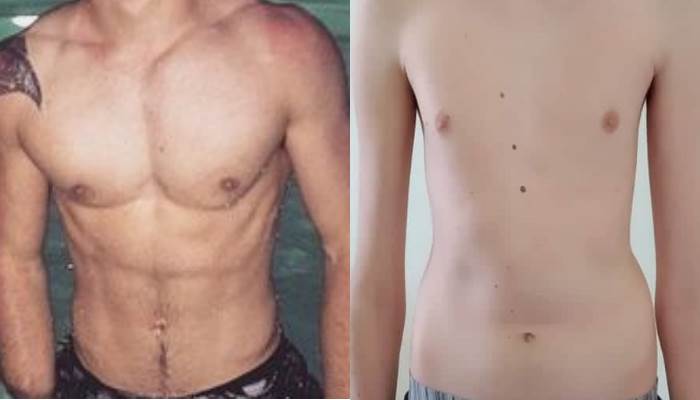
Diet and Training for Ectomorphs Skynny Fat
What does it mean to be ectomorph?
A body is defined as ectomorphic when it has a longline, slender structure, with long levers, with little musculature, with acute (more closed) epigastric angle.
These are naturally lean subjects.
There are two different types of ectomorphs:
- ectomorphic ripped (or muscular/trophic): low percentage of body fat (BF), low presence of subcutaneous fat (and thin pliche), sympathetic-dominant and tend to hyperactive, good and evident musculature (even when not trained have greater muscle hardness), tolerate cold well and have a high body temperature, good insulin sensitivity, good leptinal sensitivity
- ectomorphic skinny fat (or atrophic/fake lean/lean fat): medium-high percentage of BF, localized fat, tending to parasympathetic-dominance (lazy), poor musculature (they are softer), oftenlate shoulder blades, often cold extremities, poor insulin sensitivity and leptinics.
There are several types of skinny fat: atrophic subject with high BF, atrophic subject but with not too high BF, ex overweight that has lost weight only and exclusively with the diet and the result is a seemingly lean subject, with still a good percentage of BF associated with muscle hypotrophy.
Here images to better make the idea of the difference between the two types of ectomorphs, ripped and skinny fat.

Fig 1. A). Ripped Ectomorphic B) Ectomorphic Skinny Fat
In this article we will focus on skinny fat.
Skinny Fat
Ectomorphs skinny fat are subjects who usually eat so much and badly, the protein intake in the diet is poor, they are de-trained and poorly predisposed to muscle growth. The result is the picture described in the previous paragraph: a subject who does not increase body weight (while eating so much and badly) but who has a high percentage of BF.
In the field of fitness, the common mistake is to think that these subjects need to be put in high heat in order to "mass".
no, that's not the case. Their poor insulin and leptinic sensitivity will ensure that there is poor nitrogen retention and, in supercharging, partitioning will not be efficient and cravings will increase towards sweets and carbohydrates, leading to an increase in bf especially in the periombelical area.
These subjects are physiologically very similar to overweight individuals, the organism works in a similar way:
There is a picture of chronic latent inflammation (adipose tissue is a real organ that produces a whole series of pro-inflammatory molecules such as TNF- alpha. IL-6). This picture of chronic latent inflammation causes there to be poor resilience and poor stressor management.
In addition, the tendency to parasympathetic-dominance and poor activation of sympathetic CNS, will cause there to be a lower TDEE than ripped ectomorphs and poor activation even during workouts.
Skinny fats are programmed to conserve energy
Ectomorphic skinny fat have a rather high number of adipocytes and this will ensure that their organism is always "greedy" for nutrients, ready to "store" reserves and increase body fat especially when overfeeding is not well planned, when it is not coordinated with a suitable workout and, above all, when it is not preceded by a cut (caloric cut).
Nutritional Strategy
Before thinking about "putting mass" you must first decrease your body fat levels and restore a functional hormonal picture, then you can talk about a bulk phase (building/increasing calories).
Skinny fat + Calorie cut and proper workout = Skinny
So you can from "lean fat" to "skinny only", with better muscle trophism and lower body fat levels (see Fig. 2 A -> B).

Fig 2. A). Start of the journey after already 2 weeks of low-calorie. B) end cut, start of maintenance
At first there is not even a need for a precise food plan, the important thing is:
- start faily train them (already only training will allow an improvement in body composition)
- optimize the protein percentage (2 g/kg, you can also use EAA) to enhance the mTOR-p70s6k route (they are subjects who tend to eat little protein but a lot of simple fats and sugars/junk food)
- set a low-calorie normocaloric or light (based on the starting BF)
That's it!
The first two are mandatory points, otherwise we can work even on food education, on the education of food categories and macronutrients in order to improve the quality of food and allow more informed choices.
The "difficult" part will be to make these subjects (and their relatives understand, especially when the patient is underage) that do not need to eat more... or at least not right away.
An early-journey overfeeding will only result in an increase in BF and extracellular fluids due to their metabolic and hormonal picture.
As you can switch from a normo to a low-calorie one: you have to decrease the BF and go down below the set point, this will be the new opoint (see Fig. 2-B above).
Generally:
Proteins: 2 g/kg
Fat: 0.6-0.8 g/kg
Carbohydrates: remaining share
That's for how long? For as long as it takes.
Usually the period can vary from 6 to 16 weeks (1 month and a half-4 months) and here, usually, you face another "difficult situation": the patient and/or relatives are afraid of weight loss:
-"But the boy was already thin, he must not lose weight!" -.
In certain situations, communication is essential, so that a relationship of trust between patient (and family) and professional is established.
Once the BF has been reduced and the new starting point has been established, a normocaloric/maintenance (3-6 weeks) can be used to consolidate the results obtained.
In later times you can switch to a bulk phase (with increased body weight) by constantly monitoring body composition and feedback (fat mass must remain unchanged or there may be a small increase in proportion to the acquired weight).
At this stage, timing is also important: it may be useful to take advantage of mixed fasting 4:8 pm or time restricted feeding
How to set up a bulk:
– increase carbohydrates in meals near training
– increase carbohydrates even in the most distant meals
– increase fats or recharge fat
Before each change, feedback should be monitored and evaluated. Not only aesthetic feedback but also levels of perceived well-being, focus, lucidity intra workout and in work/study.
Why increase fat?
Why during (re)construction and increased glucidic altitude, there will be a time when the CHO/FAT axis will be shifted in favor of carbohydrates. If the weight does not rise further, a further increase in carbohydrates will not solve the situation, the thyroid is "crazy" and there would only be "an acceleration" of the subject.
In this phase of increase it is necessary to curb the metabolism of the subject with fats, a macronutrient that does not act as a "stimulant".
It can be done in several ways:
– Recharge: single day of hyperlipid
– Short-term increase: a few days or a couple of weeks of increase in the average fat
– Long-term increase: there is no set time frame but, quite simply, the situation is monitored.
The ideal weight gain is equal to 1.5% of body weight every month but can vary between 1-2%. In case you go beyond this range it is good to take a step back.
If there are difficulties in the intake of high doses of food, some strategies can be used:
- use of energy-dense foods (not necessarily junk food)
- palatable foods at the beginning of the meal
- spices and herbs to vary

Fig 3. bulk start
Training Strategy
if I had to create a priority order, I would do so
1. Technique for executing and improving the motor scheme
2. Improve the ability to activate, propriocetion and strength
3. Load and effort intensity
4. Volume and work on deficient groups
It is useless to do workouts rich in volume if you are not strong enough, the loads that would be used to stay at high repetitions would not involve any adaptation and, therefore, no improvement.
Without adaptation there is no hypertrophy!
Working on the motor scheme and setting up workouts with neural and high intensity stimuli lends itself very well to caloric and glucidic restriction.
At high intensities the stimuli will be short, the recovery will be rapid and there is no dent in the reserves of glicogen.
Not only that!
The high intensity promotes the oxidative capacity of muscle fibers and induces an increase in mitochondrialdensity (fundamental to improve the metabolic picture).
There is also more compliance towards training: a factor not to be underestimated!
During the maintenance phase, the volumes in training can be increased in such a way as to consolidate the results obtained in the previous phase and make long-term improvements from a metabolic point of view.
In the phase of "mass" and "reconstruction", given the increased amount of energy, it is useful to reinsert jobs with neural stimula, heavy but short, involving large muscle masses and coordination between different muscle districts.
Not only that!
Metabolic diseases and acids which will be used to promote the storage of glycogen.
The result will be:
- fullness and muscle volume
- muscle hardness.
(see Fig. 3, bulk start)
The choice of exercises, modes, loads, live times etc... will be established according to the characteristics of the subject: endocrine, metabolic, postural, biomechanical characteristics.
Dott.ssa Patalano Myriam Biologist Nutritionist
Ischia Nutrizione Patalano
